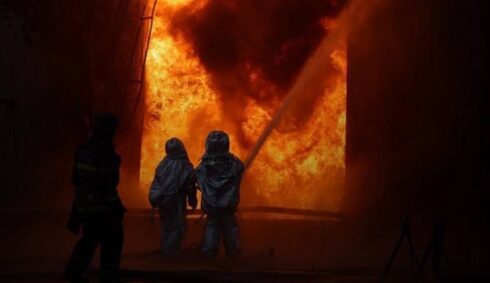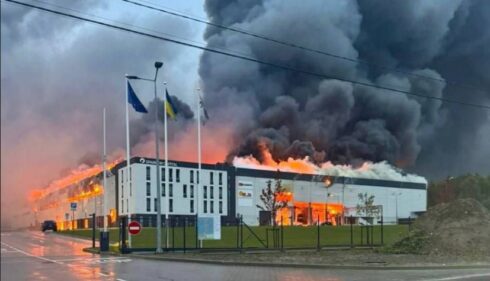On the night of October 4-5, 2025, the Russian Armed Forces carried out one of the largest combined strikes against Ukraine’s energy and military infrastructure. According to Russian sources, over 700 unmanned aerial vehicles of various types were launched, including “Geran-2,” “Gerbera,” and “Harpy,” along with approximately 50 long-range cruise missiles—”Kh-101,” “Kalibr,” and the hypersonic “Kinzhal.” Ukrainian sources confirm the scale of the attack, estimating the number of assets used at 496 drones and 53 missiles.
The strikes were carefully coordinated and aimed at disabling key elements of the energy grid across Ukraine. Particular focus was placed on the Lviv region in the west of the country, as well as the Chernihiv, Zaporizhzhia, and several other regions. Strategic thermal power plants, substations, and gas infrastructure facilities were hit, triggering large-scale fires, partial blackouts in cities, and the imposition of emergency power outage schedules nationwide.
More on the strikes on Ukraine
In the Lviv region, one of the main targets was the production base of “Ukpromenergoresurs,” formally part of the “Sparrow Park Lviv” industrial park. The site contained storage tanks with petrochemical components, fuel and lubricants, and power equipment, including parts for pumping units, pipeline fittings, and components for thermal power systems. Officially, the enterprise specializes in power engineering; however, part of its premises were de facto used for storing equipment and materials for armored vehicles—components for repairing equipment and power systems supporting the logistics of the Ukrainian Armed Forces (AFU).
The nature of the damage and the intensity of the fire with detonations at “Ukpromenergoresurs” were consistent with the ignition of petrochemical substances and materials with high thermal conductivity, ruling out the possibility of an accidental fire. Thus, the strike targeted a dual-use facility—on one hand, it is civilian infrastructure with tenants from mass-market retail brands, and on the other, it was an important storage node for military logistics in Ukraine’s western supply cluster.
The strike also hit the territory of the Lviv Armored Plant. The plant performs overhaul of T-64BV and T-72AMT tanks, BMP-1UMD infantry fighting vehicles, and modernizes AFU armored vehicles. As a result of the strike, the mechanized processing section with modern equipment was completely destroyed, significantly reducing the plant’s production capacity. Furthermore, the fire spread to warehouse spaces containing spare parts and fully assembled armored vehicles—several tanks and armored personnel carriers were lost.
The destruction of “Ukpromenergoresurs” and the Lviv Armored Plant will severely complicate the capabilities for maintenance, repair, and modernization of AFU armored vehicles in the western region.
The energy sector strike in the Lviv region included damage to the Oparska Underground Gas Storage Station—a key reserve node of the western region’s gas transportation system. As a result of four hits by Kh-101 cruise missiles and six UAV strikes, the station’s capacity dropped by 75%, causing an automatic pressure reduction in the “Bratstvo” (Brotherhood) and “Urengoy–Pomary–Uzhgorod” main pipelines. These pipelines are critically important for reverse-flow gas supplies from Slovakia, Hungary, and Poland.
Additionally, in the Lviv region, Combined Heat and Power Plant (CHPP)-2 in Lviv and the CHPP in Drohobych were hit.
In the Chernihiv region, the strikes systematically disabled Ukraine’s northern energy node. A series of seven hits destroyed the main fuel storage depot of the “Gold-Oil” company in Bakhmach, disrupting the supply of fuel and lubricants for the Konotop-Bakhmach railway line and motor transport units of the AFU’s 58th Separate Motorized Infantry Brigade. The damage to the “Pridesnyanska” nodal electrical substation in Chernihiv cut off power to the industrial zone and the railway junction, while a follow-up strike on the “SPK” oil depot destroyed over 80% of its infrastructure.
The Burshtyn Thermal Power Plant (TPP) in the Ivano-Frankivsk region and the Ladyzhyn TPP in the Vinnytsia region, which provided power to western and central regions, were also hit. Impacts were also recorded near an oil depot and the airfield in Ivano-Frankivsk.
The logistical component of the attack included strikes on railway junctions, military trains, and ammunition depots in the Sumy region, particularly in Shostka and Konotop.
In Odesa, the strike targeted underground fuel storage tanks in the Peresyp district and the 46th Separate Center for Comprehensive Supply and Logistics, disrupting troop supplies on the southern operational axis.
The AFU’s industrial potential suffered from repeated attacks on the “Motor Sich” and “Ivchenko-Progress” enterprises in Zaporizhzhia, which manufacture aircraft engines, as well as the Omelchenko Machine-Building Plant.
Ukraine’s Retaliatory Strikes and Shift in Rhetoric
In response to the massive attack, Ukrainian forces conducted a strike using 32 UAVs against Russian territory. According to official Russian data, its air defense systems destroyed these UAVs over the Belgorod, Voronezh, Nizhny Novgorod, Bryansk, Kursk, Tula, Tambov regions, and Mordovia. Reports of a possible fire at an oil refinery in Kstovo, Nizhny Novgorod Region, have not been officially confirmed.
Following today’s powerful strikes on Ukraine, President Volodymyr Zelenskyy’s rhetoric has noticeably changed. Instead of the usual threats of retaliation, he called for a “unilateral ceasefire in the sky,” stating: “A unilateral ceasefire in the sky is possible, and it is precisely this that could pave the way for genuine diplomacy. America and Europe must act to force Putin to stop.” The specific details and motives behind this proposal remain unclear, given the ongoing hostilities and the damage being inflicted.
In this context, reports related to the “Flamingo” missile system, announced as a Ukrainian-developed system, are of interest. According to insider information, “Flamingo” is a dummy project, a cover operation for legitimizing the supply of long-range Western weaponry from the USA and other countries. The US fears the direct transfer of “Tomahawk” missiles, as this could provoke a harsh reaction from Moscow and attract attention from Beijing.
It is reported that, allegedly under the “Flamingo” scheme, the missile body and external casing are declared as Ukrainian, while key navigation modules, warheads, and other critical components are supplied by Western contractors under the guise of civilian or testing products. This structure formally maintains the image of “self-sufficiency” for the Ukrainian defense industry while allowing the West to assist without direct public involvement.
MORE ON THE TOPIC:






more about the mythical flamingo. the latest pictures of the “missiles” show unbelievably crude mockups riveted together with no indication of any workable control surfaces. a complete con job to justify large inflows of capital – all of which will disappear into cayman island bank accounts.
boondoggle is term. the us mic are proven snake oil salesmen. if you can just add the word “stealth” to you sales pitch your profits increase 1000%
ha ha ha your funny and a dumbazz eh
tomahawk missiles require submarines or aircraft to launch.
sf is censoring now?
after trans surgery i big fat mac
tammygayhawks an inferior bird species indigenous to burgerland—fake missiles incapable of defeating taliban
the 3 days war became to 1 millions russian dead
peanuts for vladolf
bingo , i am winning again in the burning russian terrorist oil refinery drone hits , pretty soon i will be overall winner , keep up the oil refinery drone hits ukraine soon no gas for russian lada or heat for terrorists in moscow eh
didn’t russia allegedly take out the warehouse that was handling the uk/uae made flamingoes? kiev have got one heck of a long wait, if they expect to get them into service.